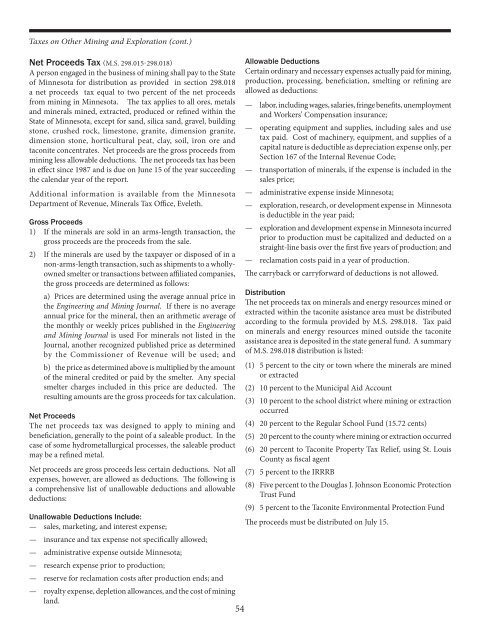Mining Tax Guide - Minnesota State Legislature
Mining Tax Guide - Minnesota State Legislature
Mining Tax Guide - Minnesota State Legislature
You also want an ePaper? Increase the reach of your titles
YUMPU automatically turns print PDFs into web optimized ePapers that Google loves.
<strong>Tax</strong>es on Other <strong>Mining</strong> and Exploration (cont.)<br />
Net Proceeds <strong>Tax</strong> (M.S. 298.015-298.018)<br />
A person engaged in the business of mining shall pay to the <strong>State</strong><br />
of <strong>Minnesota</strong> for distribution as provided in section 298.018<br />
a net proceeds tax equal to two percent of the net proceeds<br />
from mining in <strong>Minnesota</strong>. The tax applies to all ores, metals<br />
and minerals mined, extracted, produced or refined within the<br />
<strong>State</strong> of <strong>Minnesota</strong>, except for sand, silica sand, gravel, building<br />
stone, crushed rock, limestone, granite, dimension granite,<br />
dimension stone, horticultural peat, clay, soil, iron ore and<br />
taconite concentrates. Net proceeds are the gross proceeds from<br />
mining less allowable deductions. The net proceeds tax has been<br />
in effect since 1987 and is due on June 15 of the year succeeding<br />
the calendar year of the report.<br />
Additional information is available from the <strong>Minnesota</strong><br />
Department of Revenue, Minerals <strong>Tax</strong> Office, Eveleth.<br />
Gross Proceeds<br />
1) If the minerals are sold in an arms-length transaction, the<br />
gross proceeds are the proceeds from the sale.<br />
2) If the minerals are used by the taxpayer or disposed of in a<br />
non-arms-length transaction, such as shipments to a whollyowned<br />
smelter or transactions between affiliated companies,<br />
the gross proceeds are determined as follows:<br />
a) Prices are determined using the average annual price in<br />
the Engineering and <strong>Mining</strong> Journal. If there is no average<br />
annual price for the mineral, then an arithmetic average of<br />
the monthly or weekly prices published in the Engineering<br />
and <strong>Mining</strong> Journal is used For minerals not listed in the<br />
Journal, another recognized published price as determined<br />
by the Commissioner of Revenue will be used; and<br />
b) the price as determined above is multiplied by the amount<br />
of the mineral credited or paid by the smelter. Any special<br />
smelter charges included in this price are deducted. The<br />
resulting amounts are the gross proceeds for tax calculation.<br />
Net Proceeds<br />
The net proceeds tax was designed to apply to mining and<br />
beneficiation, generally to the point of a saleable product. In the<br />
case of some hydrometallurgical processes, the saleable product<br />
may be a refined metal.<br />
Net proceeds are gross proceeds less certain deductions. Not all<br />
expenses, however, are allowed as deductions. The following is<br />
a comprehensive list of unallowable deductions and allowable<br />
deductions:<br />
Unallowable Deductions Include:<br />
— sales, marketing, and interest expense;<br />
— insurance and tax expense not specifically allowed;<br />
— administrative expense outside <strong>Minnesota</strong>;<br />
— research expense prior to production;<br />
— reserve for reclamation costs after production ends; and<br />
— royalty expense, depletion allowances, and the cost of mining<br />
land.<br />
54<br />
Allowable Deductions<br />
Certain ordinary and necessary expenses actually paid for mining,<br />
production, processing, beneficiation, smelting or refining are<br />
allowed as deductions:<br />
— labor, including wages, salaries, fringe benefits, unemployment<br />
and Workers’ Compensation insurance;<br />
— operating equipment and supplies, including sales and use<br />
tax paid. Cost of machinery, equipment, and supplies of a<br />
capital nature is deductible as depreciation expense only, per<br />
Section 167 of the Internal Revenue Code;<br />
— transportation of minerals, if the expense is included in the<br />
sales price;<br />
— administrative expense inside <strong>Minnesota</strong>;<br />
— exploration, research, or development expense in <strong>Minnesota</strong><br />
is deductible in the year paid;<br />
— exploration and development expense in <strong>Minnesota</strong> incurred<br />
prior to production must be capitalized and deducted on a<br />
straight-line basis over the first five years of production; and<br />
— reclamation costs paid in a year of production.<br />
The carryback or carryforward of deductions is not allowed.<br />
Distribution<br />
The net proceeds tax on minerals and energy resources mined or<br />
extracted within the taconite asistance area must be distributed<br />
according to the formula provided by M.S. 298.018. <strong>Tax</strong> paid<br />
on minerals and energy resources mined outside the taconite<br />
assistance area is deposited in the state general fund. A summary<br />
of M.S. 298.018 distribution is listed:<br />
(1) 5 percent to the city or town where the minerals are mined<br />
or extracted<br />
(2) 10 percent to the Municipal Aid Account<br />
(3) 10 percent to the school district where mining or extraction<br />
occurred<br />
(4) 20 percent to the Regular School Fund (15.72 cents)<br />
(5) 20 percent to the county where mining or extraction occurred<br />
(6) 20 percent to Taconite Property <strong>Tax</strong> Relief, using St. Louis<br />
County as fiscal agent<br />
(7) 5 percent to the IRRRB<br />
(8) Five percent to the Douglas J. Johnson Economic Protection<br />
Trust Fund<br />
(9) 5 percent to the Taconite Environmental Protection Fund<br />
The proceeds must be distributed on July 15.

















